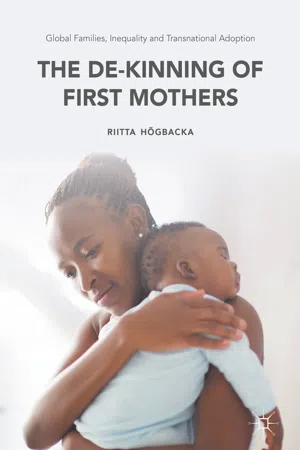These excerpts from interviews with a South African first mother and a Finnish adoptive mother I met during the course of my research illuminate the contradictions inherent in transnational adoption and some of the basic issues addressed in this book. Contrary to popular belief, most adopted children are not orphans but have living mothers (or other kin) in the country of origin (Briggs and Marre 2009, 12; Cantwell 2014, 75; Fonseca 2004, 178; Hoelgaard 1998, 230; Johnson 2012). The emotional landscape of transnational adoption thus encompasses not only joy and happiness, but also sadness, grief and feelings of loss. Given the acknowledged importance of going beyond the principles of methodological nationalism that approach ‘the study of social and historical processes as if they were contained within the borders of individual nation-states’ (Glick Schiller and Salazar 2013, 186), this book examines both ends of the adoption chain, with a special focus on the family of origin. In so doing it draws on and extends previous studies, which in addition to focusing on the adopting family (Brian 2012; Choy 2013; Gailey 2010; Jacobson 2008; Seligmann 2013; Stryker 2010; Wegar 2006) have started to consider the perspectives of the countries of origin at least to some extent, and lately also more comprehensively (Briggs 2012; Dorow 2006a; Dubinsky 2010; Gibbons and Rotabi 2012; Howell 2006; Johnson 2004; Leinaweaver 2008; Marre and Briggs 2009; Volkman 2005), as well as investigating adult adoptees’ linkages to the country of origin (Hübinette 2006; Kim 2010) and their journeys back and reunions with kin (Prébin 2013; Yngvesson 2010). First mothers of transnationally adopted children have rarely occupied centre stage in the studies (but see Bos 2007). The book at hand is dedicated to giving space to first mothers, their struggles and concerns.We had been trying for so many years. […] Getting a child brought tears to my eyes. […] Attachment to these children, my husband says this as well, attachment comes within 24 hours. […] Very strong feelings of attachment. […] It’s like getting a lapful of gold. […] [We want to give this child] optimal opportunities. […] everything that he could possibly need. (Anna, adoptive mother)So I had to give up the baby. […] I couldn’t bear thinking that I’m bringing this baby to life and then she’s going to be miserable and I wasn’t going to give her nothing but misery. But so but I could give her life and then give it to somebody who’ll give her such a wonderful life, education, everything. […] It’s still hurting so much. I don’t know what time I’ll ever forget it. I just wondered, will my baby one day ask, mom where were you when I started to walk, mom where were you when I started teething (cries). (Simphiwe, first mother)

Global Families, Inequality and Transnational Adoption
The De-Kinning of First Mothers
- English
- ePUB (mobile friendly)
- Available on iOS & Android
Global Families, Inequality and Transnational Adoption
The De-Kinning of First Mothers
About This Book
This book looks at the simultaneous processes of making and un-making of families that are part of the adoption practice. Whereas most studies on transnational adoption concentrate on the adoptive family, the author identifies not only the happy occasion when a family gains a child, but also the sorrow and loss of the child to its family of origin. Situating transnational adoption in the context of the Global North-South divide, Hogbacka investigates the devastating effects of unequal life chances and asymmetrical power relations on the adoption process and on the mothers whose children are adopted. Based on unique primary material gathered in in-depth interviews with South African families of origin and Finnish adoptive families, the book investigates the decision-making processes of both sets of parents and the encounters between them. The first mothers' narratives are juxtaposed with those of the adopters and of the adoption social workers who act on the principles of the wider adoption system. Concluding with a critique of the Global Northism that exemplifies current practices, Hogbacka sketches the contours of a more just approach to transnational adoption that would shatter rather than perpetuate inequality. The book can also be read as an expose of the consequences of current inequalities for poor families. Global Families, Inequality and Transnational Adoption will be of interest to students and scholars of adoption studies, family and kinship, sociology, anthropology, social work and development.
Frequently asked questions
Information
1. Introduction: The Global in the Family
Table of contents
- Cover
- Frontmatter
- 1. Introduction: The Global in the Family
- 2. Adoption and Family in the Global North and South
- 3. The Making of the Adoptive Family: Choosing Family
- 4. The Un-Making of the Family of Origin: Adoption Social Workers as Intermediaries
- 5. First Mothers’ Stunted Choices
- 6. Inequality Among First Mothers: The Power of Resources
- 7. Re-Making Family: The Struggle Over Belonging
- 8. Contact Over Time
- 9. Conclusion: Re-Kinning First Mothers
- Backmatter